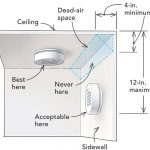 Carbon monoxide didn’t earn its nickname as the silent killer without good reason, and you can prevent this deadly gas from unknowingly seeping into your Western New York home. As a leading home inspection company in the Buffalo area, we’re consistently stressing the importance of having your heating systems professionally cleaned and maintained as a prime way to protect your family against carbon monoxide poisoning. Outfitting your home with carbon monoxide detectors is another.
Carbon monoxide didn’t earn its nickname as the silent killer without good reason, and you can prevent this deadly gas from unknowingly seeping into your Western New York home. As a leading home inspection company in the Buffalo area, we’re consistently stressing the importance of having your heating systems professionally cleaned and maintained as a prime way to protect your family against carbon monoxide poisoning. Outfitting your home with carbon monoxide detectors is another.
Where Does Carbon Monoxide Come From?
Carbon monoxide is produced when fuels don’t burn completely, such as natural gas, propane, gasoline, wood, coal and other fossil fuels. Heating and cooking equipment inside the home are possible sources of carbon monoxide, as are generators and vehicles inside an attached garage.
Carbon Monoxide Dangers
High levels of carbon monoxide can be deadly. High levels can accumulate by being exposed to small amounts of carbon monoxide over an extended period of time, or by larger amounts of carbon monoxide over a shorter length of time.
Protecting Your Family with Carbon Monoxide Detectors
Carbon monoxide detectors are designed to alert you when carbon monoxide is present in your Western New York home. State regulations and recommendations from the National Fire Prevention Association provide guidelines to ensure you and your family are fully protected.
Where to Place CO Detectors:
- High on the wall or ceiling
- On every floor where a source of CO exists, such as cooking appliances and fireplaces
- At least 15 feet away from fireplaces, wood stoves and other appliances that burn fossil fuel
- At least 5 to 10 feet away from kitchen appliances and bathrooms
- In every bedroom
- In hallways or rooms opening to an attached garage
- In living areas directly above an attached garage
For homes built after Jan. 1, 2008, New York State regulations dictate two more requirements for CO detectors. They must be hardwired into your home’s electrical system and come equipped with a battery backup. They must also be interconnected; when one CO alarm sounds, all CO detectors must sound.
As CO detector designs can vary, make sure you review and follow manufacturer’s directions to ensure proper placement and usage.
Statistics from the National Fire Protection Association (NFPA) indicate how helpful CO detectors have been as their use has continued to increase. The number of non-fire carbon monoxide incidents where CO was found in homes across the nation rose from 40,900 in 2003 to 80,100 in 2010.
As more people use carbon monoxide detectors, more people can become alerted to CO presence in their homes before it reaches deadly levels. Review and inspect the CO detectors in your Buffalo area home today.


